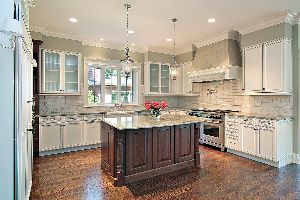
These days, perhaps the most popular goal many homeowners have in mind when remodeling a kitchen is functionality through design. To that end, mobile kitchen islands have quickly become a priority for those who want to maximize space and utility. You can make use of an endless array of building materials and design options if you decide to build your own island, so take a look at what you should know before getting to work.
A Short Guide to Mobile Kitchen Island Design
Building Materials
You can choose from a wide array of building materials for the body of your kitchen island, including steel, aluminum, and vinyl. The most versatile and easily-crafted, however, is wood, particularly for DIY-minded homeowners.
More affordable materials include soft pine, plywood, or medium-density fiberboard (MDF). However, you can get better and longer-lasting results by using mid-range hardwoods like oak and maple, with premium materials like chestnut, teak, or walnut for the countertop. You’ll also need a variety of screws, fasteners, and nuts, as well as sturdy caster wheels for the base.

Current Design Trends
The latest trends in kitchen island design tend towards simplicity and sturdy construction, with rustic farmhouse elements being particularly popular. Most DIY designs incorporate simple shelving below the countertop, although more skilled craftspeople can add elements such as drawers, under-counter hanging storage, and deep pull-out drawers for waste bins.
If you have plenty of floor space in your kitchen, you can combine some or all of these features into a single highly functional island. Smaller options include building a butcher block into the countertop for extra food prep space, or one with a basic countertop and a single shelf below for storing essentials.
The Process
The first step in building your own kitchen island is to find a pattern suited to your needs, preferences, and available space and budget. Once you’ve chosen a pattern, buy the necessary building materials and cut your boards and panels to size. Next, assemble the prepared panels into the rough shape of the finished product before fitting the shelves or drawer brackets. Finally, attach the casters and the countertop before finishing or painting the unit as desired.
When you’re looking for top-quality materials for your next DIY project, visit Butler County Lumber Company. Serving Greater Hamilton and Cincinnati, OH areas since 1912, they offer first-class building materials including premium woods, paints and stains, hardware, and more. Call (513) 896-6660 to discuss your needs, and visit them online to learn more about their products.
About the Business
(60 reviews)
Have a question? Ask the experts!
Send your question

